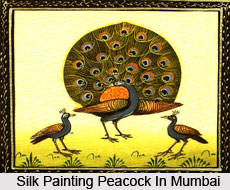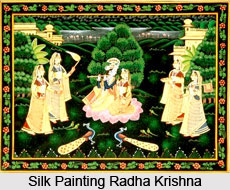 Silk Paintings is a unique type of Indian paintings and is used to create a sense of mystique. The silk paintings that are generally made in India emphasises elegance, softness and flexibility of design and style. Silk is dexterously used as a canvas for painting and portrait. Skilled and talented Indian artists make use of a special process that actually helps to "hold" the paint on silk canvas in vibrant details.
Silk Paintings is a unique type of Indian paintings and is used to create a sense of mystique. The silk paintings that are generally made in India emphasises elegance, softness and flexibility of design and style. Silk is dexterously used as a canvas for painting and portrait. Skilled and talented Indian artists make use of a special process that actually helps to "hold" the paint on silk canvas in vibrant details.
Origin of Silk Painting
In India, the silk painting can be traced back to the 2nd Century A.D. where the wax resist technique was used for decorating silks. During the Mughal era in the 17-19th Centuries it was at its most popular with many wall hangings and portrait pictures being produced.
Nature of Silk Painting
Silk paintings have a timeless appeal and their design, beauty, style and elegance give them a high status acceptance. The style of silk painting can be diverse and the texture and motif can range from coarse and ethnic to refined and intricate. Silk painting is actually creating art on fabric with silk on canvas. Even the simplest painting on silk is beautiful because of the glow and warmth of the silk shining through. Silk painting has many usages. It can be used can as wall hanging, functional, such as wearable art or for home decor. The heavy use of gold appears as another distinguishing characteristic to highlight the patterns. Silk paintings are usually used to depict rich court life, religious themes and epics. It often makes use of glitters, gemstones and gold. Silk painting is the process of applying dye to silks. It is often used as ties, scarves or clothing. The finished works can also be wall hangings, framed pictures or household decor. Making of silk painting is fun and easy and the process takes less time, where no particular experience in art is required. Artists can surely look to create beautiful original paintings on silk. The silk glows with extra vibrancy and lustre.
This type of painting is almost opposite to other types of paintings. Here, the artist generally paints by controlling the pigments on the surface. Brushes become much less important because the dye will move on the silk after it is placed there. Because the dyes flow so freely on silk, the job of the silk painter is to control the movement of the pigment on the silk rather than its placement
Process of Silk Painting
•Firstly, the silk is washed with warm water.
•When slightly damp, the cloth needs to be ironed.
•The design is created with the help of a stencil.
•A stretching frame is made with rubber bands, hooks and cardboards. The purpose for making the frame stretchable is because to create enough tension so that the silk remains tight enough while the painting is done.
•A Gutta or Resist is applied with the help of an applicator on the design. There should not be any gaps for the dyes to escape. Dry it before applying any paintings.
•Apply the paint with the help of a paint brush.
•Setting the dyes with the help of steam and heat. This produces a richness to the colours that has been applied. This can also be done with chemical fixatives such as Tinfix and Jacquard.
•Once the dye or paint has been properly fixed, the gutta is removed by dry cleaning.
•Lastly, when the resist is removed, hang dry and iron the silk while it is slightly damp.
 Other Silk Painting Techniques
Other Silk Painting Techniques
Silk painters can also add dimension with color, shading, and various surface techniques. The challenge for silk painters is to add dimension and to vary the effects on the surface. Detailed patterns without applying resists can be achieved by priming the prewashed and stretched silk with a stop-flow primer. The primer is left to dry before painting on the silk.
Watercolor Effects can be achieved by not using resists. Dyes or paints are applied to the silk with a paint brush, mist sprayer, eye dropper or other tools to achieve abstract effects. Sprinkling silk salt on the piece when still wet and leaving until completely dry before brushing off the salt, produces interesting textural effects. Applying alcohol to dye-painted silk can also create beautiful effects. The use of salt, alcohol effects, wet-on-wet treatment, and wet-on-dry painting are common in silk painting. However, the effects on silk are often more dramatic than on paper.



















